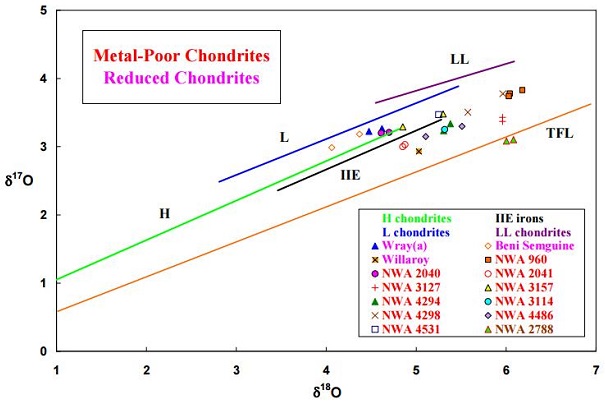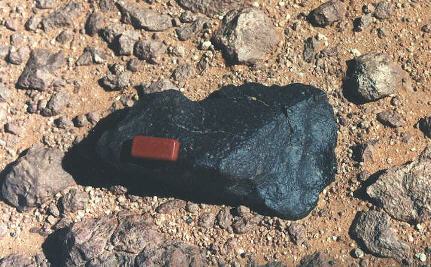HaH 180
ChondriteChondrites are the most common meteorites accounting for ~84% of falls. Chondrites are comprised mostly of Fe- and Mg-bearing silicate minerals (found in both chondrules and fine grained matrix), reduced Fe/Ni metal (found in various states like large blebs, small grains and/or even chondrule rims), and various refractory inclusions (such Click on Term to Read More, Type 3.5-ungrouped
Found April 1996
28° 36.21′ N., 13° 18.04′ E. Six pieces of this highly unequilibrated meteoriteWork in progress. A solid natural object reaching a planet’s surface from interplanetary space. Solid portion of a meteoroid that survives its fall to Earth, or some other body. Meteorites are classified as stony meteorites, iron meteorites, and stony-iron meteorites. These groups are further divided according to their mineralogy and Click on Term to Read More were recovered in Ash Shati’, Libya, having a total combined weight of 936 g. The oxygen three-isotope diagram for HaH 180, constructed by Achim Raphael from published data, has values that plot slightly above the TFL and within a field occupied by a small number of anomalous, ungroupedModifying term used to describe meteorites that are mineralogically and/or chemically unique and defy classification into the group or sub-group they most closely resemble. Some examples include Ungrouped Achondrite (achondrite-ung), Ungrouped Chondrite (chondrite-ung), Ungrouped Iron (iron-ung), and Ungrouped Carbonaceous (C-ung). Click on Term to Read More, non-carbonaceous chondritesChondrites are the most common meteorites accounting for ~84% of falls. Chondrites are comprised mostly of Fe- and Mg-bearing silicate minerals (found in both chondrules and fine grained matrix), reduced Fe/Ni metal (found in various states like large blebs, small grains and/or even chondrule rims), and various refractory inclusions (such Click on Term to Read More, including NWA 960, NWA 2335, and NWA 2336. Together with the NWA-series meteorites 2040 [LL], 2041 [L], 3114 [L], 3127 [LL], 3157 [L], 4294 [LL], 4298 [LL], 4486 [L], 4531 [LL], 5717 [L+LL; photo courtesy of Paul Swartz], NWA 7835 [ungrouped achondriteAn achondrite is a type of stony meteorite whose precursor was of chondritic origin and experienced metamorphic and igneous processes. They have a planetary or differentiated asteroidal origin where the chondritic parent body reached a sufficient size that through heating due to radioactive decay of 26Al (aluminum isotope) and gravitational Click on Term to Read More; Irving et al., 2014, #5332; photo courtesy of Stefan Ralew], and NWA 10769 [ungrouped achondrite; Moggi Cecchi et al., 2016, #2696], O-isotopic values infer a possible ‘supra-TFL’ genetic grouping for these meteorites which together plot along a slope distinct from the ordinary chondrites (H, L, and LL) on an oxygenElement that makes up 20.95 vol. % of the Earth's atmosphere at ground level, 89 wt. % of seawater and 46.6 wt. % (94 vol. %) of Earth's crust. It appears to be the third most abundant element in the universe (after H and He), but has an abundance only Click on Term to Read More three-isotope diagram. It is demonstrated in the diagram below that these meteorites plot far away from the trend lines for the H, L, and LL ordinary chondriteWork in Progress Ordinary chondrites (OCs) are the largest meteorite clan, comprising approximately 87% of the global collection and 78% of all falls (Meteoritical Society database 2018)1. Meteorites & the Early Solar System: page 581 section 6.1 OC of type 5 or 6 with an apparent shock stage of S1, Click on Term to Read More groups, and they probably represent several previously unrecognized parent asteroids (Irving et al., 2014, #5332). 
Diagram credit: Rumble III et al., 38th LPSC, #2230 (2007) The mineralogy of HaH 180 consists of olivineGroup of silicate minerals, (Mg,Fe)2SiO4, with the compositional endpoints of forsterite (Mg2SiO4) and fayalite (Fe2SiO4). Olivine is commonly found in all chondrites within both the matrix and chondrules, achondrites including most primitive achondrites and some evolved achondrites, in pallasites as large yellow-green crystals (brown when terrestrialized), in the silicate portion Click on Term to Read More and Fe-rich pyroxeneA class of silicate (SiO3) minerals that form a solid solution between iron and magnesium and can contain up to 50% calcium. Pyroxenes are important rock forming minerals and critical to understanding igneous processes. For more detailed information, please read the Pyroxene Group article found in the Meteoritics & Classification category. Click on Term to Read More and excludes a relationship with E chondrites. This meteorite is very weakly shocked to stage S2 and highly weathered to grade W4. Studies of the bulk chemical and mineralInorganic substance that is (1) naturally occurring (but does not have a biologic or man-made origin) and formed by physical (not biological) forces with a (2) defined chemical composition of limited variation, has a (3) distinctive set of of physical properties including being a solid, and has a (4) homogeneous Click on Term to Read More composition and petrographic features of both HaH 180 and the similar Deakin 001 suggest an affinity to LL-group chondrites. The anomalously high 18O compositions could be explained by unusually high terrestrial weathering effects, or that these unequilibrated ordinary chondrites sample a wider range of oxygen isotopeOne of two or more atoms with the same atomic number (Z), but different mass (A). For example, hydrogen has three isotopes: 1H, 2H (deuterium), and 3H (tritium). Different isotopes of a given element have different numbers of neutrons in the nucleus. Click on Term to Read More compositions than previously identified. On the other hand, these meteorites might represent a unique chondritic parent bodyThe body from which a meteorite or meteoroid was derived prior to its ejection. Some parent bodies were destroyed early in the formation of our Solar System, while others like the asteroid 4-Vesta and Mars are still observable today. Click on Term to Read More. Interestingly, a dark inclusionFragment of foreign (xeno-) material enclosed within the primary matrix of a rock or meteorite. Click on Term to Read More found in the LL3.3 chondrite Wells has an O-isotope composition that plots close to HaH 180, as does a silica-rich orthopyroxeniteA rock composed primarily of orthopyroxene. Non-terrestrial orthopyoxenites include diogenites and a single martian meteorite, ALH 84001, that was found in the Allan Hills region of Antarctica in 1984. ALH 84001 is a cumulate rock consisting of 97% coarse-grained, Mg-rich orthopyroxene, with small amounts of plagioclase, chromite, and carbonate. It Click on Term to Read More inclusion found in the L3 chondrite Bovedy.








